2017 NISSAN LEAF remote control
[x] Cancel search: remote controlPage 12 of 424
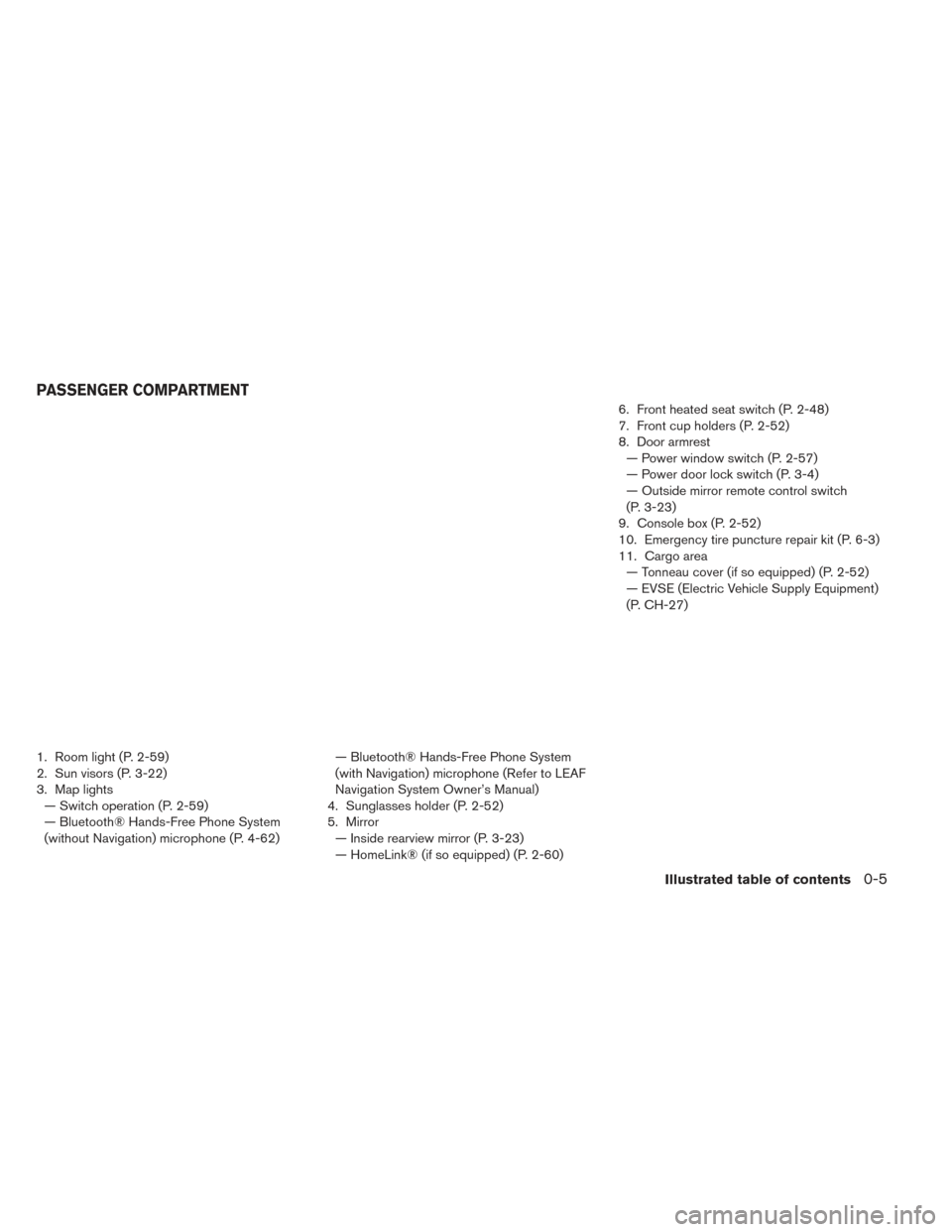
1. Room light (P. 2-59)
2. Sun visors (P. 3-22)
3. Map lights— Switch operation (P. 2-59)
— Bluetooth® Hands-Free Phone System
(without Navigation) microphone (P. 4-62) — Bluetooth® Hands-Free Phone System
(with Navigation) microphone (Refer to LEAF
Navigation System Owner’s Manual)
4. Sunglasses holder (P. 2-52)
5. Mirror — Inside rearview mirror (P. 3-23)
— HomeLink® (if so equipped) (P. 2-60) 6. Front heated seat switch (P. 2-48)
7. Front cup holders (P. 2-52)
8. Door armrest
— Power window switch (P. 2-57)
— Power door lock switch (P. 3-4)
— Outside mirror remote control switch
(P. 3-23)
9. Console box (P. 2-52)
10. Emergency tire puncture repair kit (P. 6-3)
11. Cargo area — Tonneau cover (if so equipped) (P. 2-52)
— EVSE (Electric Vehicle Supply Equipment)
(P. CH-27)
PASSENGER COMPARTMENT
Illustrated table of contents0-5
Page 25 of 424
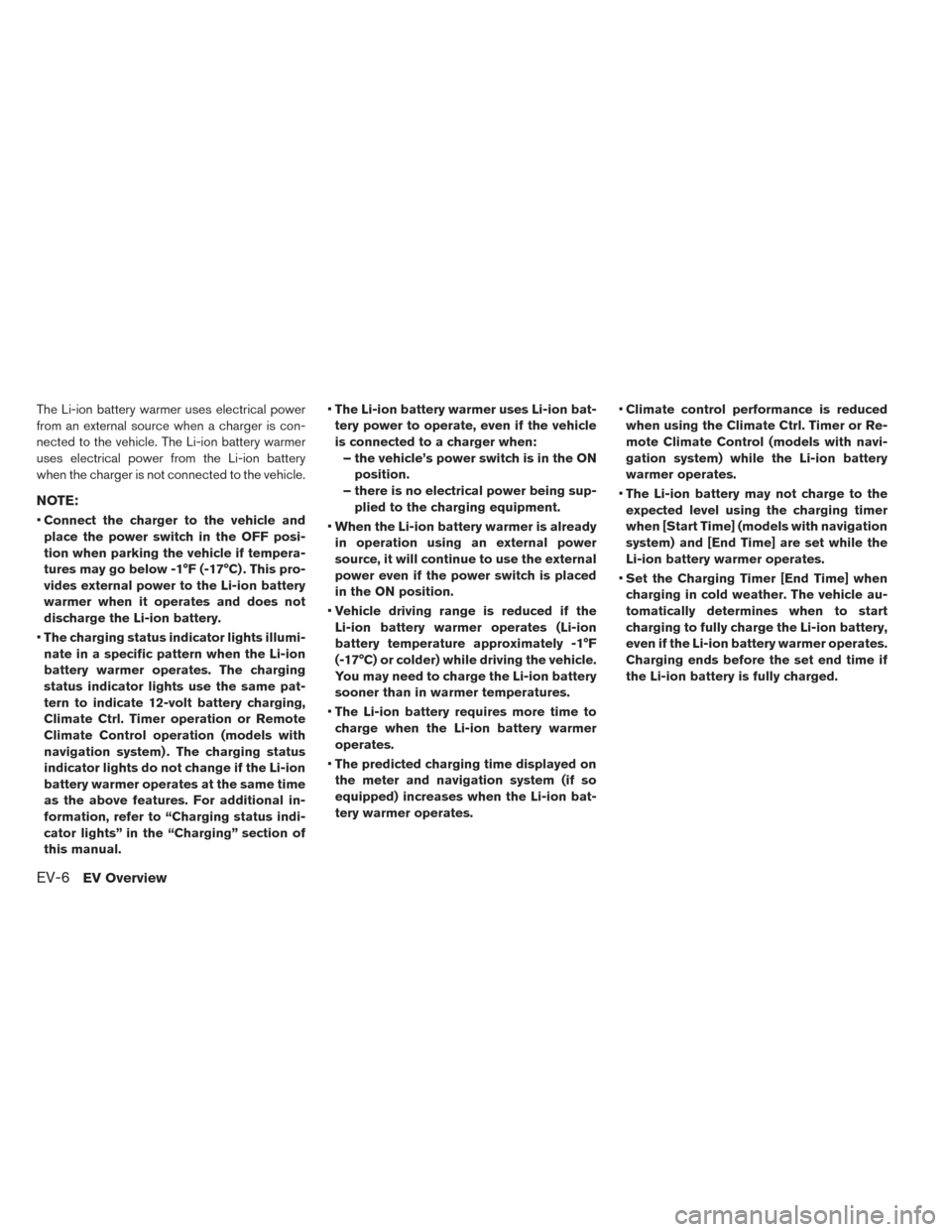
The Li-ion battery warmer uses electrical power
from an external source when a charger is con-
nected to the vehicle. The Li-ion battery warmer
uses electrical power from the Li-ion battery
when the charger is not connected to the vehicle.
NOTE:
•Connect the charger to the vehicle and
place the power switch in the OFF posi-
tion when parking the vehicle if tempera-
tures may go below -1°F (-17°C) . This pro-
vides external power to the Li-ion battery
warmer when it operates and does not
discharge the Li-ion battery.
• The charging status indicator lights illumi-
nate in a specific pattern when the Li-ion
battery warmer operates. The charging
status indicator lights use the same pat-
tern to indicate 12-volt battery charging,
Climate Ctrl. Timer operation or Remote
Climate Control operation (models with
navigation system) . The charging status
indicator lights do not change if the Li-ion
battery warmer operates at the same time
as the above features. For additional in-
formation, refer to “Charging status indi-
cator lights” in the “Charging” section of
this manual. •
The Li-ion battery warmer uses Li-ion bat-
tery power to operate, even if the vehicle
is connected to a charger when: – the vehicle’s power switch is in the ON position.
– there is no electrical power being sup- plied to the charging equipment.
• When the Li-ion battery warmer is already
in operation using an external power
source, it will continue to use the external
power even if the power switch is placed
in the ON position.
• Vehicle driving range is reduced if the
Li-ion battery warmer operates (Li-ion
battery temperature approximately -1°F
(-17°C) or colder) while driving the vehicle.
You may need to charge the Li-ion battery
sooner than in warmer temperatures.
• The Li-ion battery requires more time to
charge when the Li-ion battery warmer
operates.
• The predicted charging time displayed on
the meter and navigation system (if so
equipped) increases when the Li-ion bat-
tery warmer operates. •
Climate control performance is reduced
when using the Climate Ctrl. Timer or Re-
mote Climate Control (models with navi-
gation system) while the Li-ion battery
warmer operates.
• The Li-ion battery may not charge to the
expected level using the charging timer
when [Start Time] (models with navigation
system) and [End Time] are set while the
Li-ion battery warmer operates.
• Set the Charging Timer [End Time] when
charging in cold weather. The vehicle au-
tomatically determines when to start
charging to fully charge the Li-ion battery,
even if the Li-ion battery warmer operates.
Charging ends before the set end time if
the Li-ion battery is fully charged.
EV-6EV Overview
Page 29 of 424
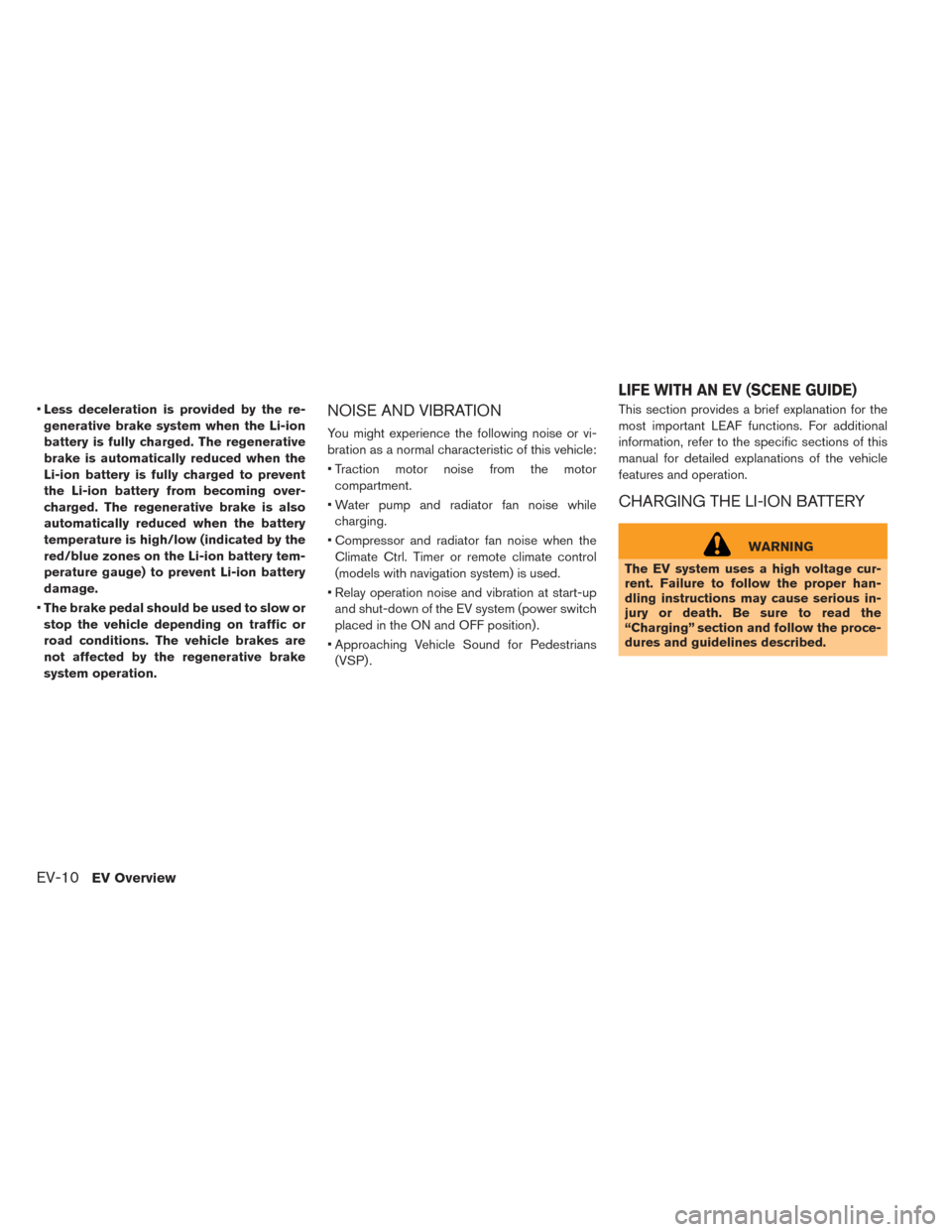
•Less deceleration is provided by the re-
generative brake system when the Li-ion
battery is fully charged. The regenerative
brake is automatically reduced when the
Li-ion battery is fully charged to prevent
the Li-ion battery from becoming over-
charged. The regenerative brake is also
automatically reduced when the battery
temperature is high/low (indicated by the
red/blue zones on the Li-ion battery tem-
perature gauge) to prevent Li-ion battery
damage.
• The brake pedal should be used to slow or
stop the vehicle depending on traffic or
road conditions. The vehicle brakes are
not affected by the regenerative brake
system operation.NOISE AND VIBRATION
You might experience the following noise or vi-
bration as a normal characteristic of this vehicle:
• Traction motor noise from the motor compartment.
• Water pump and radiator fan noise while charging.
• Compressor and radiator fan noise when the Climate Ctrl. Timer or remote climate control
(models with navigation system) is used.
• Relay operation noise and vibration at start-up and shut-down of the EV system (power switch
placed in the ON and OFF position) .
• Approaching Vehicle Sound for Pedestrians (VSP) . This section provides a brief explanation for the
most important LEAF functions. For additional
information, refer to the specific sections of this
manual for detailed explanations of the vehicle
features and operation.
CHARGING THE LI-ION BATTERY
WARNING
The EV system uses a high voltage cur-
rent. Failure to follow the proper han-
dling instructions may cause serious in-
jury or death. Be sure to read the
“Charging” section and follow the proce-
dures and guidelines described.
LIFE WITH AN EV (SCENE GUIDE)
EV-10EV Overview
Page 34 of 424
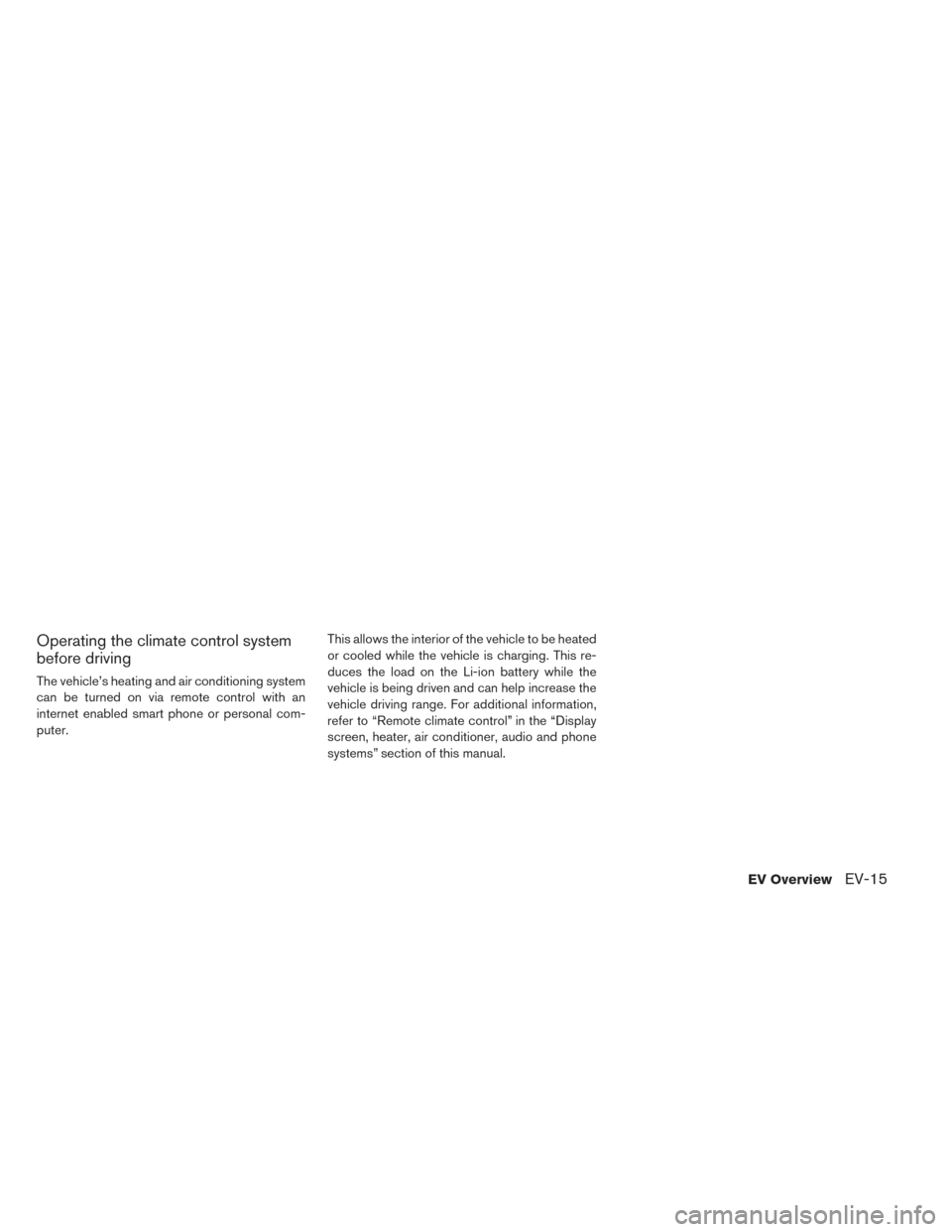
Operating the climate control system
before driving
The vehicle’s heating and air conditioning system
can be turned on via remote control with an
internet enabled smart phone or personal com-
puter.This allows the interior of the vehicle to be heated
or cooled while the vehicle is charging. This re-
duces the load on the Li-ion battery while the
vehicle is being driven and can help increase the
vehicle driving range. For additional information,
refer to “Remote climate control” in the “Display
screen, heater, air conditioner, audio and phone
systems” section of this manual.
EV OverviewEV-15
Page 41 of 424
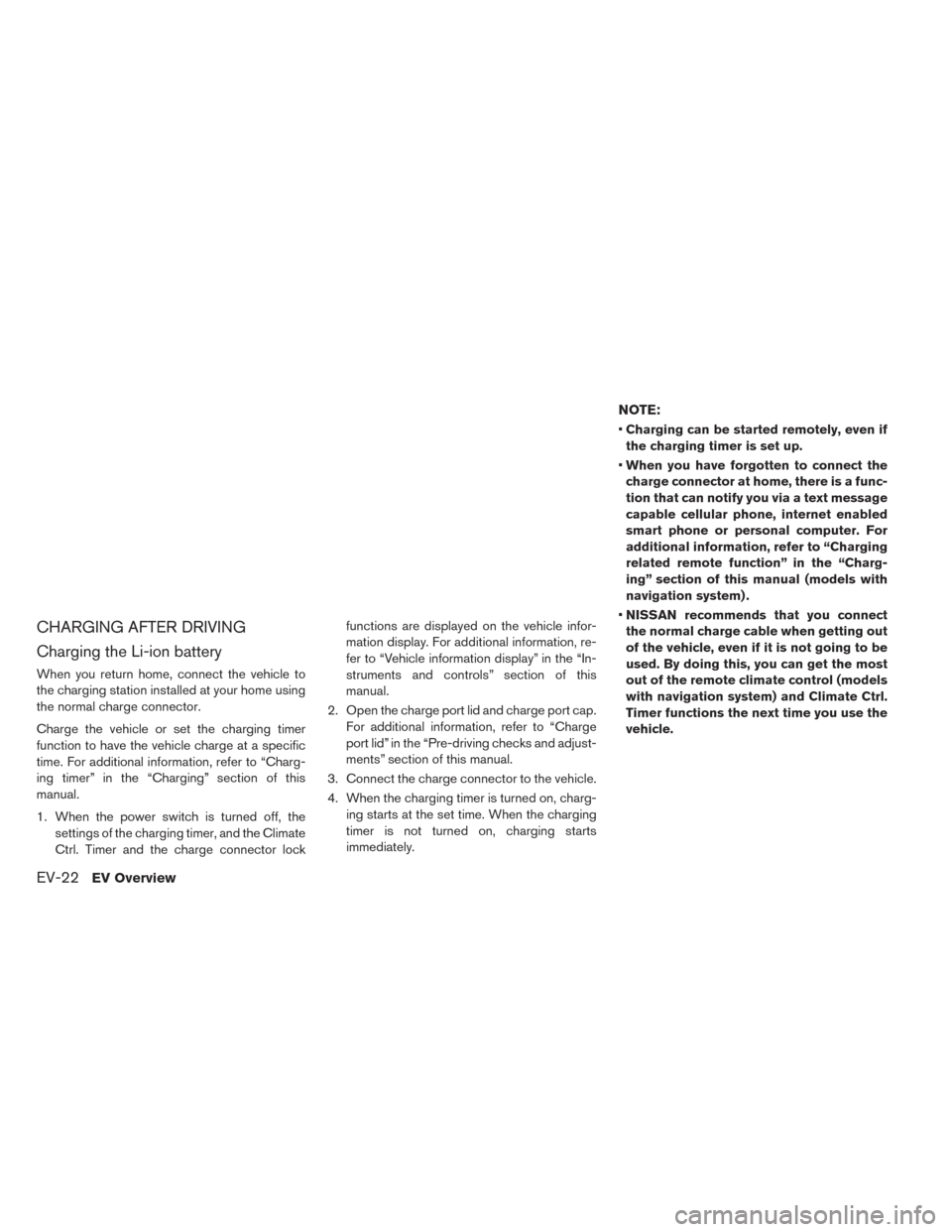
CHARGING AFTER DRIVING
Charging the Li-ion battery
When you return home, connect the vehicle to
the charging station installed at your home using
the normal charge connector.
Charge the vehicle or set the charging timer
function to have the vehicle charge at a specific
time. For additional information, refer to “Charg-
ing timer” in the “Charging” section of this
manual.
1. When the power switch is turned off, thesettings of the charging timer, and the Climate
Ctrl. Timer and the charge connector lock functions are displayed on the vehicle infor-
mation display. For additional information, re-
fer to “Vehicle information display” in the “In-
struments and controls” section of this
manual.
2. Open the charge port lid and charge port cap. For additional information, refer to “Charge
port lid” in the “Pre-driving checks and adjust-
ments” section of this manual.
3. Connect the charge connector to the vehicle.
4. When the charging timer is turned on, charg- ing starts at the set time. When the charging
timer is not turned on, charging starts
immediately.
NOTE:
•Charging can be started remotely, even if
the charging timer is set up.
• When you have forgotten to connect the
charge connector at home, there is a func-
tion that can notify you via a text message
capable cellular phone, internet enabled
smart phone or personal computer. For
additional information, refer to “Charging
related remote function” in the “Charg-
ing” section of this manual (models with
navigation system) .
• NISSAN recommends that you connect
the normal charge cable when getting out
of the vehicle, even if it is not going to be
used. By doing this, you can get the most
out of the remote climate control (models
with navigation system) and Climate Ctrl.
Timer functions the next time you use the
vehicle.
EV-22EV Overview
Page 50 of 424
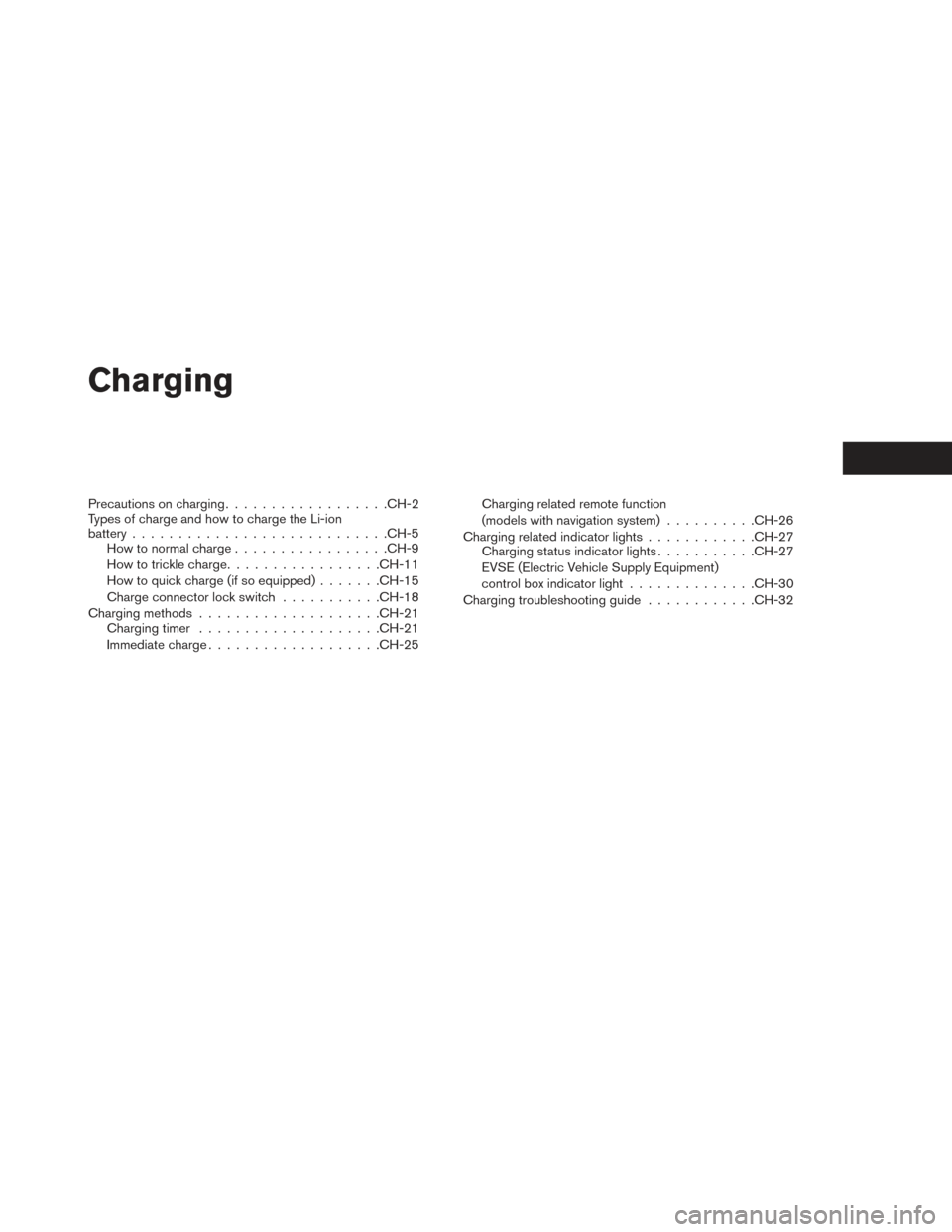
Charging
Precautions on charging................. .CH-2
Types of charge and how to charge the Li-ion
battery ........................... .CH-5
How to normal charge ................ .CH-9
How to trickle charge ................ .CH-11
How to quick charge (if so equipped) .......CH-15
Charge connector lock switch ...........CH-18
Charging methods ................... .CH-21
Charging timer ................... .CH-21
Immediate charge .................. .CH-25Charging related remote function
(models with navigation system)
..........CH-26
Charging related indicator lights ............CH-27
Charging status indicator lights ...........CH-27
EVSE (Electric Vehicle Supply Equipment)
control box indicator light ..............CH-30
Charging troubleshooting guide ............CH-32
Page 53 of 424
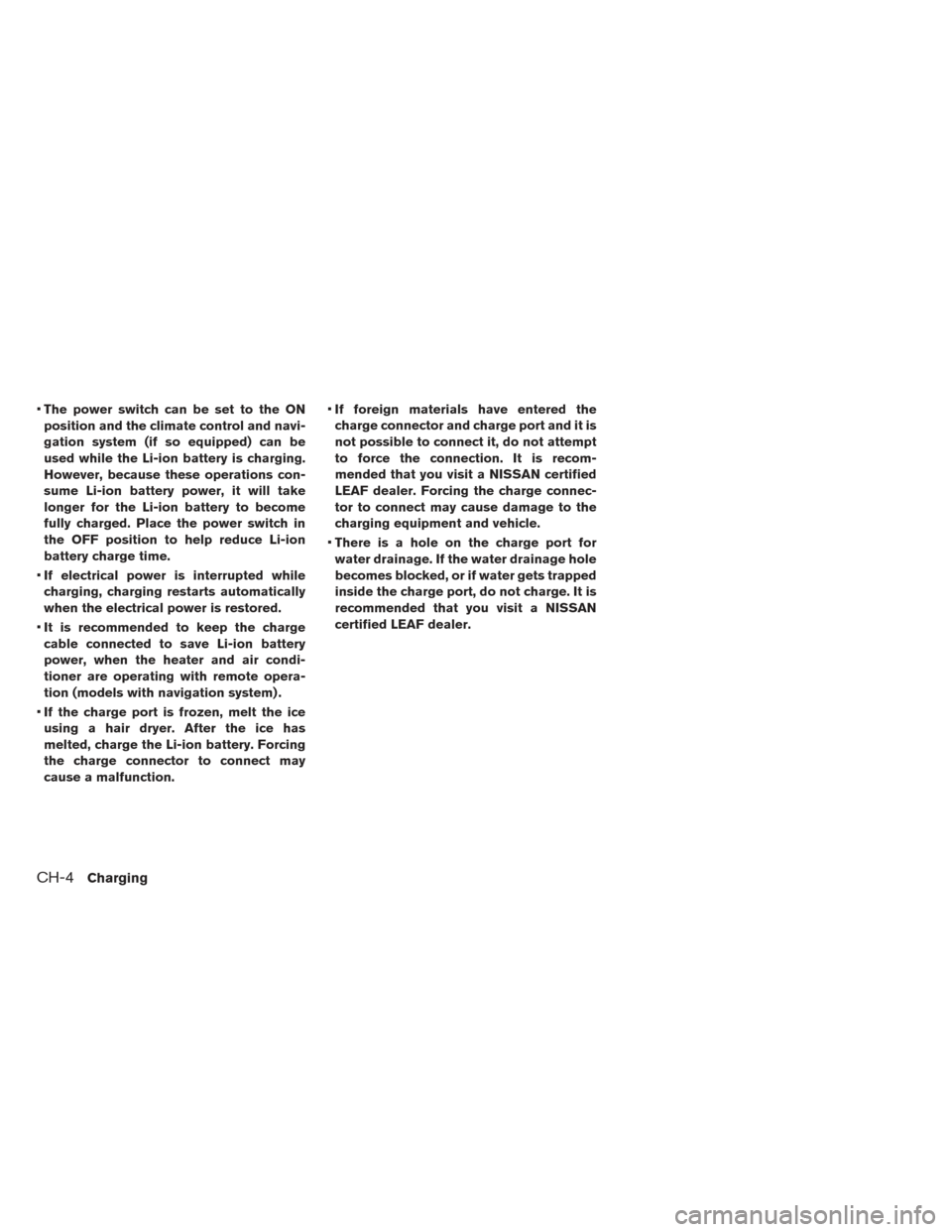
•The power switch can be set to the ON
position and the climate control and navi-
gation system (if so equipped) can be
used while the Li-ion battery is charging.
However, because these operations con-
sume Li-ion battery power, it will take
longer for the Li-ion battery to become
fully charged. Place the power switch in
the OFF position to help reduce Li-ion
battery charge time.
• If electrical power is interrupted while
charging, charging restarts automatically
when the electrical power is restored.
• It is recommended to keep the charge
cable connected to save Li-ion battery
power, when the heater and air condi-
tioner are operating with remote opera-
tion (models with navigation system) .
• If the charge port is frozen, melt the ice
using a hair dryer. After the ice has
melted, charge the Li-ion battery. Forcing
the charge connector to connect may
cause a malfunction. •
If foreign materials have entered the
charge connector and charge port and it is
not possible to connect it, do not attempt
to force the connection. It is recom-
mended that you visit a NISSAN certified
LEAF dealer. Forcing the charge connec-
tor to connect may cause damage to the
charging equipment and vehicle.
• There is a hole on the charge port for
water drainage. If the water drainage hole
becomes blocked, or if water gets trapped
inside the charge port, do not charge. It is
recommended that you visit a NISSAN
certified LEAF dealer.
CH-4Charging
Page 59 of 424
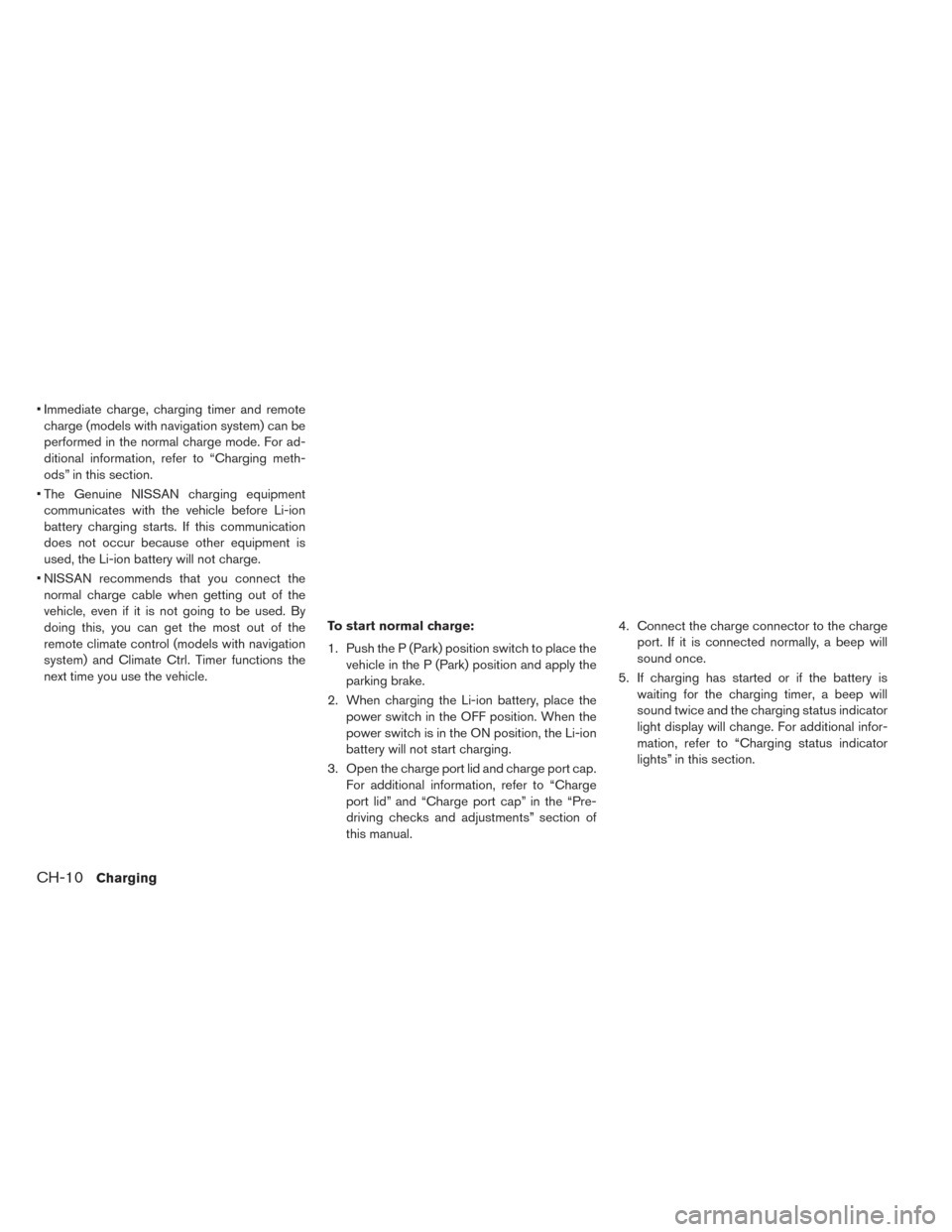
• Immediate charge, charging timer and remotecharge (models with navigation system) can be
performed in the normal charge mode. For ad-
ditional information, refer to “Charging meth-
ods” in this section.
• The Genuine NISSAN charging equipment communicates with the vehicle before Li-ion
battery charging starts. If this communication
does not occur because other equipment is
used, the Li-ion battery will not charge.
• NISSAN recommends that you connect the normal charge cable when getting out of the
vehicle, even if it is not going to be used. By
doing this, you can get the most out of the
remote climate control (models with navigation
system) and Climate Ctrl. Timer functions the
next time you use the vehicle. To start normal charge:
1. Push the P (Park) position switch to place the
vehicle in the P (Park) position and apply the
parking brake.
2. When charging the Li-ion battery, place the power switch in the OFF position. When the
power switch is in the ON position, the Li-ion
battery will not start charging.
3. Open the charge port lid and charge port cap. For additional information, refer to “Charge
port lid” and “Charge port cap” in the “Pre-
driving checks and adjustments” section of
this manual. 4. Connect the charge connector to the charge
port. If it is connected normally, a beep will
sound once.
5. If charging has started or if the battery is waiting for the charging timer, a beep will
sound twice and the charging status indicator
light display will change. For additional infor-
mation, refer to “Charging status indicator
lights” in this section.
CH-10Charging